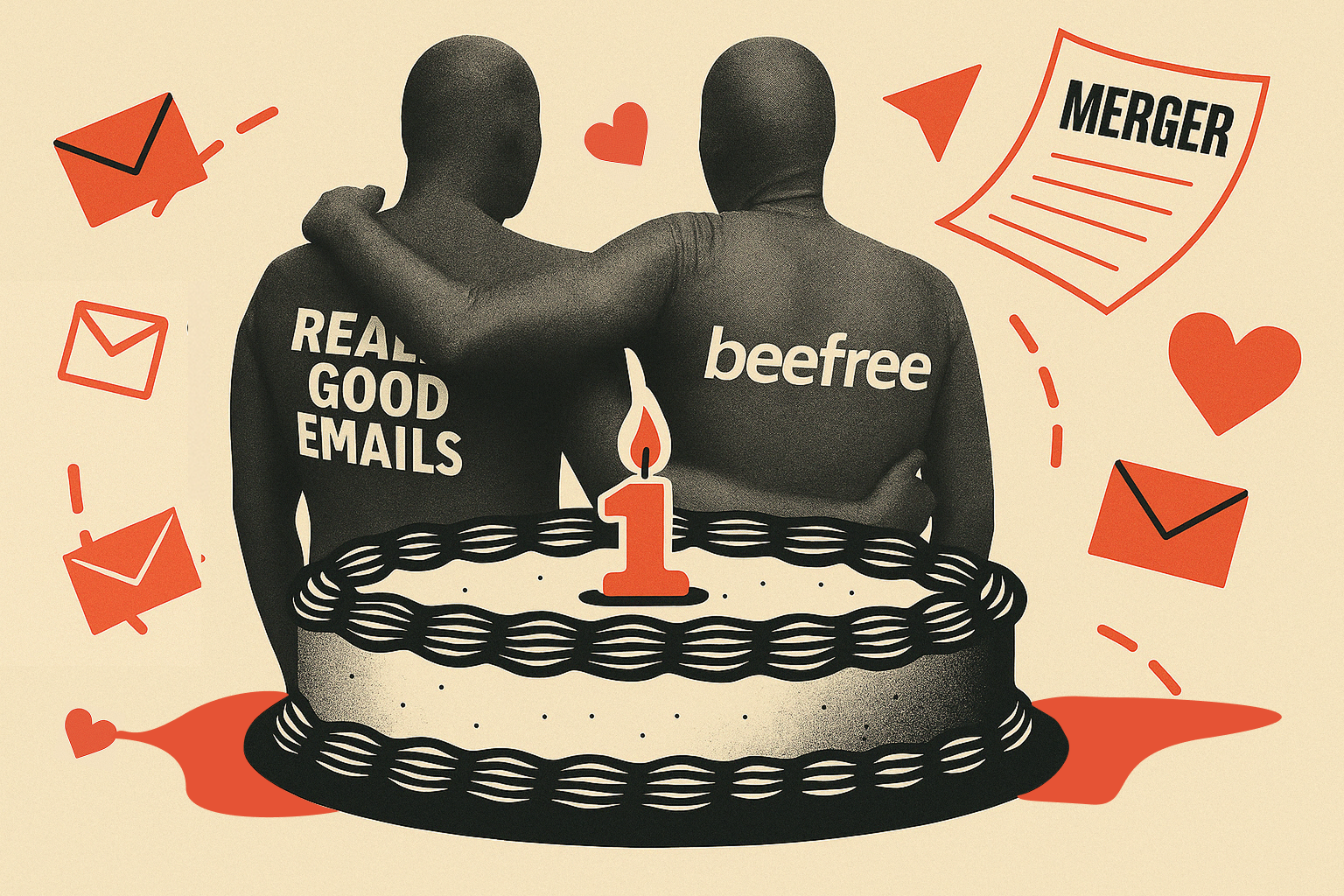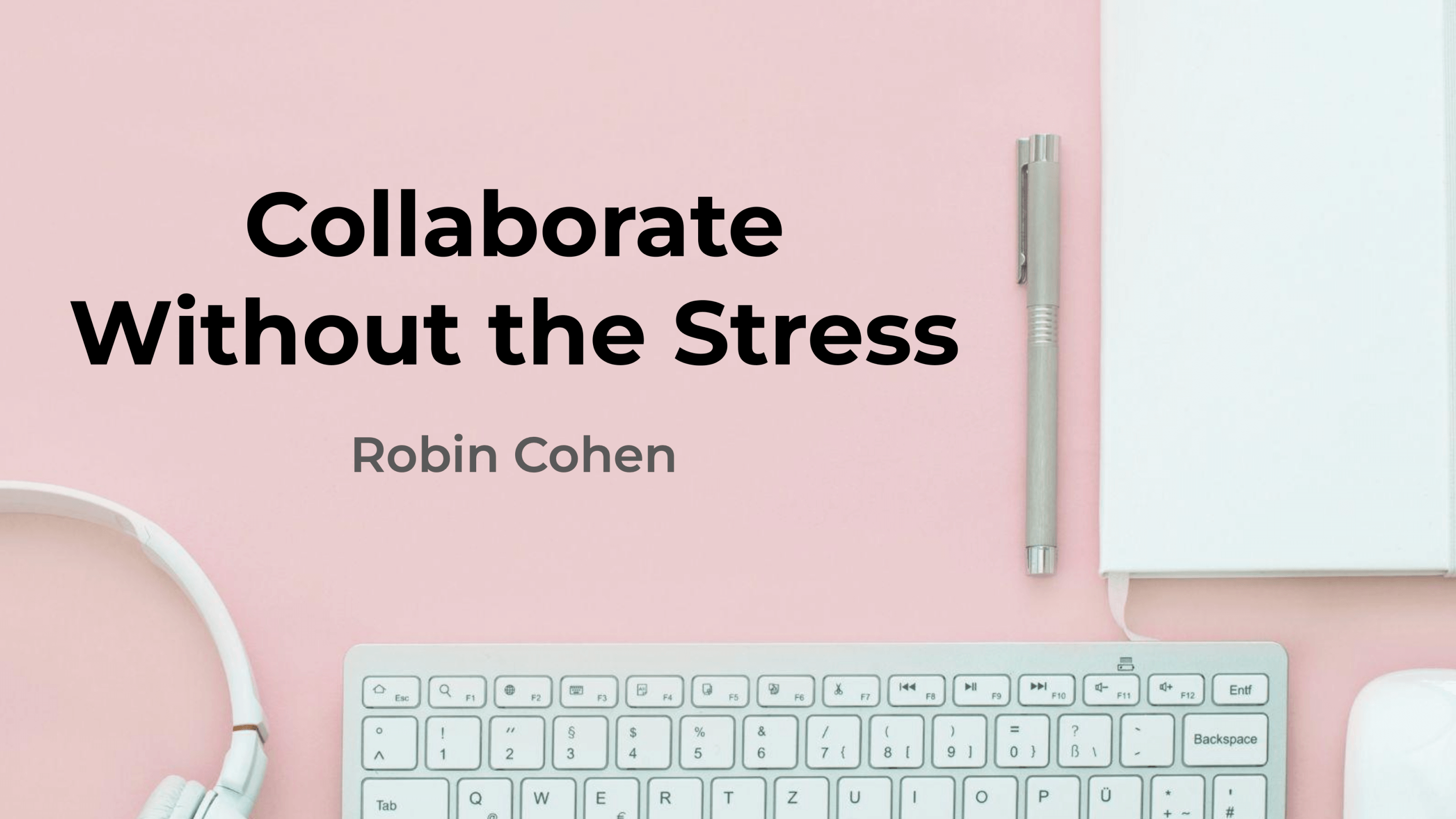Robin Cogen: Hi, I’m Robin Cohen. I’m here to chat with you about collaborating without the stress, and I’m so appreciative to be back with my email community.
A little bit about me: I’m the founder of Happier Office, and my mission is to help people and companies improve the way we work. That might mean team-building workshops, helping folks manage conflict, running facilitation sessions, or coaching.
Before Happier Office, I spent 10 years in lifecycle and email. I’ve worked on tiny teams at big-hearted brands like Wistia, and at billion-dollar companies like AllTrails and Vistaprint.
And what I learned was this: the problems are always the same. No matter where you work, what your budget is, how old your CEO is, or how awkward the staff might be — it’s all the same stuff.
And I’m here to help people navigate that in a more scalable way.
Hopefully, you can tell that I’m passionate about team dynamics, and that’s why I made this career switch.
Also, a fun fact you might’ve gotten from Justine: I’m a recovering stress baker. If you don’t know what that is, it’s when your life and work are so irritating and out of control that you just start baking everything.
Yes, thank you. All the baked goods. It’s before lunch, right? Figured I’d get you salivating. Ew — I hate that word. But here we are.
The point is: baking is controlled. It’s measured. So when work feels chaotic, baking makes me feel a little less bad. This brings me to a very technical graph you’ll want to write down.

At the start of a project, I’m making pretzels. Easy. Then things calm down — kickoff, cookies, and creative review. All is well. Then you’re 90% done, and your VP blows everything up. That’s when I’m tempering chocolate, making donuts, pastry cream — anything I can to not lose my mind. Then, things calm down again. By QA, I’m baking bread. And then we launch.
But seriously, you can’t be a good baker without the fundamentals. You have to read the recipe. You mise en place — that’s French for “get all your stuff on the counter.” You mix, taste, adjust, and then you share it with your friends.
And I know what you’re thinking: “Robin, I did not sign up for a baking lecture. What are we doing here?” But these fundamentals have a ton of parallels to work.
So, today, our agenda is all about alignment, communication, feedback, trust, and buy-in. And, of course, lots of pictures of cookies to get you hungry before lunch.

Here’s a picture of my grandma’s fruit leather recipe. If you don’t know, it’s like jam that you turn into a chewy snack. You take fruit and sugar, boil it down, purée it, spread it in a pan, and bake it.
Simple, right? But look closer. Straining, boiling, figuring out temperatures — there’s a lot of nuance. It’s the same with projects. It’s not about how many emails you’re sending. It’s about how you’re going to work with everyone involved. What context do they need to do their jobs? How are you going to navigate team dynamics?
Maybe your designer is notoriously slow. Maybe someone on the team wanted your job. These things affect the work — and they need to be planned for, not avoided.
You’re not planning for perfection. You’re planning for the hiccups that will happen. So you document everything. And you take the time to talk about how you’re going to work together.
I had a professor who used to say, “Organizational behavior is common sense that’s not commonly practiced.” And he was right.
Once you know your recipe, you need to get alignment — get all your ingredients out and measured. Don’t just bring sugar — bring one cup of sugar, because your recipe might need yolks, not whole eggs. Prepare intentionally.
The best tool? A solid kickoff.
And I don’t just mean, “Hey, here’s what we’re making.” I mean, “Here’s our goal. Here’s how we’ll get there. Here’s our meeting cadence. Here’s how we’ll build norms and rapport.” It’s much more about the how, not just the what. There’s a model I like: the Three W’s.

When are we meeting? Are we doing standups, weekly check-ins, and async reviews?
Where are we communicating? Slack for updates? Email for feedback?
What belongs in which channel?
Different types of communication work better in different places. Formal updates and reporting? That’s shared documentation. One-offs, reminders, quick questions? Slack. Detailed roadmaps? Again, shared docs. Momentum and brainstorming? In-person or virtual meetings.
The point is: match the message to the medium.
And it’s not just where — it’s also who.
You’ve got your contributors, your decision-makers, and your stakeholders.

Sit down with your team during kickoff and say, “Hey, Jennifer, you’re a contributor. Tim, you’re a stakeholder. Everyone good with that?”
Then, when someone comes back later and says, “Why wasn’t I consulted?” you have a record. It might not change the outcome, but it will help with alignment.
There are usually two key roles on a project: the Project Manager and the Individual Contributor.
If you’re the PM: define roles, over-communicate, ask for input, and be flexible.
If you’re the IC: know your schedule, advocate for your capacity, and be transparent.
So instead of just saying “Nope,” you might say, “Scaling this email to 10 languages will add 8 hours of work and push us back two weeks. We can do that, but here’s a trade-off to consider.”
Also, share progress. Don’t let work disappear into a black hole.
Even a little message in Slack like, “Hey, this campaign drove X signups” goes a long way.
In meetings, take the team’s temperature. Thumbs up, down, in the middle — “Where are we at?”
And anticipate needs. Especially your own. If you know you’ll be slammed in four weeks, schedule those check-ins now.
Ask for help. I know we’re used to just figuring it out and making it work. But seriously, people will help if you ask.
Always assume good intent. Most people aren’t trying to be difficult. Maybe they’re tired. Maybe they communicate differently. Give them grace.
Okay, so we got everyone together. Now, we need to figure out how to make the ingredients work together.
Hard skills are what we do — coding, designing, and writing. Soft skills are how we do it — managing up, anticipating needs, reading the room.
And honestly, soft skills are what make great teams great.
So ask real questions. Not just “How was your weekend?” but, “How do you like to receive requests?” or “What does it look like when you’re stressed?”
I love personality quizzes; don’t get me wrong. I’m an ENFP, you’re a Nine on the Enneagram — cool. But you don’t need all that to build trust. You just need to ask the right questions.
I do a working styles doc with every team I’m on. What motivates you? What stresses you out? How do you like to get feedback? What do you look like when you’re stressed? What are your hours or boundaries?
For example, “I don’t check email after hours. So, if you need me urgently, text me.” That avoids future resentment like, “Why isn’t Robin responding in Slack during this crisis?”

Because we already talked about it. And you texted me.
Inclusivity can feel like a loaded word, but what I really mean is: create a space that feels safe and respectful.
That might mean soliciting input from quieter teammates. Or offering feedback in multiple formats — not everyone feels comfortable speaking in a group.
It might even be as simple as watching your language. “Hey guys” is common, but not everyone identifies with that. Try “Hey everyone,” “Hi friends,” or “Hey y’all.”
Also, share knowledge. Don’t hoard your “fish” like Ron Swanson. Host a lunch-and-learn. Mentor someone.

At AllTrails, my team would freeze when asked about campaign results. So I made mock CMO questions, and we practiced in a low-stakes way. Their confidence shot up.
The way the work gets done matters more than the metrics. When you invest in the people and the team, you’ll see less turnover, stronger relationships, and better work over time.

Right before I went on maternity leave, we had a high-stakes, last-minute request. My team pulled it off — not because they had to, but because we trusted each other.
Things don’t always go to plan. Maybe your batter’s too wet. Maybe you want to add chocolate chips and pretzels. That’s feedback.
There’s verbal feedback — “This isn’t working.” “Have you tried this?”
And there’s the unspoken stuff — tone, body language.
That’s why async feedback is tricky. You lose context.
In theater, we’d say the same line in different ways. “Great work, Julie.” It could be praise or sarcasm. Tone matters.
If you want feedback, just ask. Offer context. Say, “I’m working on improving my presentations. Could you share feedback next week?”
If you’re not sure it’s the right time, ask, “Is now a good time for input, or should I wait for a later version?”
Critique the work, not the person. Assume good intent.
Here’s a real-life example. My two-year-old daughter — who’s also my boss — kept throwing her grilled cheese on the floor. So I said, “This may not have been your intention… but when you threw the grilled cheese after asking for it, it made me feel like I’m bad at making grilled cheese.”
The same goes for work: “This may not have been your intention… but giving feedback in front of leadership at the last minute set us back six weeks.” Same message. Better delivery.
Feedback isn’t just for people — it’s for projects.
Run retrospectives. Set aside time. Use a facilitator if you can. Get real input.
Try a feelings map — plot how people felt at different project milestones.
Or do a start/stop/continue with sticky notes or in FigJam. The point is to find patterns and assign owners for action items.
Okay, so we’re ready to bake.
In pastry land, there’s something called a blind bake. You weigh the crust down, hope the temp is right, and wait.
That’s risky.
Instead of blind baking, open the oven. Collaborate. That’s managing up.
Anticipate what your manager needs. What do they care about? Revenue? Risk? A weekly update can go a long way. Just say what happened, what’s next, what’s blocked. Maybe give a shout-out or two.
At Wistia, I used to send updates and get crickets. So I added snark — “Anyone reading this? Bueller?” Eventually, the CMO replied, “Hey, I never respond, but I love these. Keep ’em coming.”
Managing up is about knowing your audience, anticipating needs, and offering value before they ask. It builds trust. It reduces scrambling.
You’ve done the work. Now, share the cookies.
Shout someone out in a meeting. DM their manager. Say, “This person made it so easy.” It helps them grow. And it’s just a good human move.

To recap: over-communicate for clarity and confidence. Embrace feedback early and often. Manage with intention and value. And most of all, be a human.
Work gets better when people feel respected. This stuff is hard. It takes practice. But with time, it gets better and better.
If you want help, I’m here. I’ll leave some cards out. Thank you.


